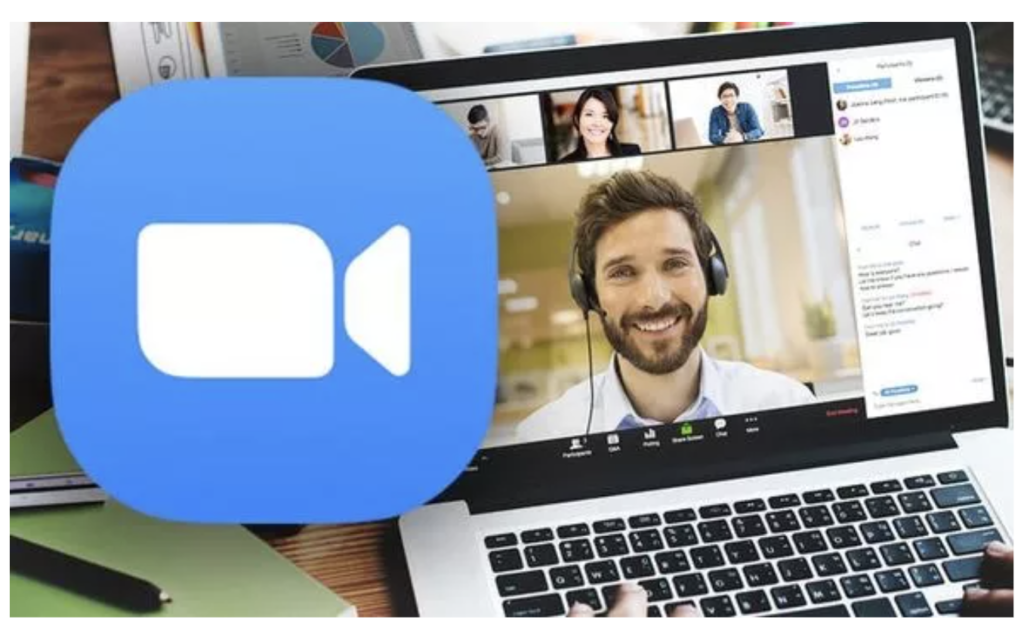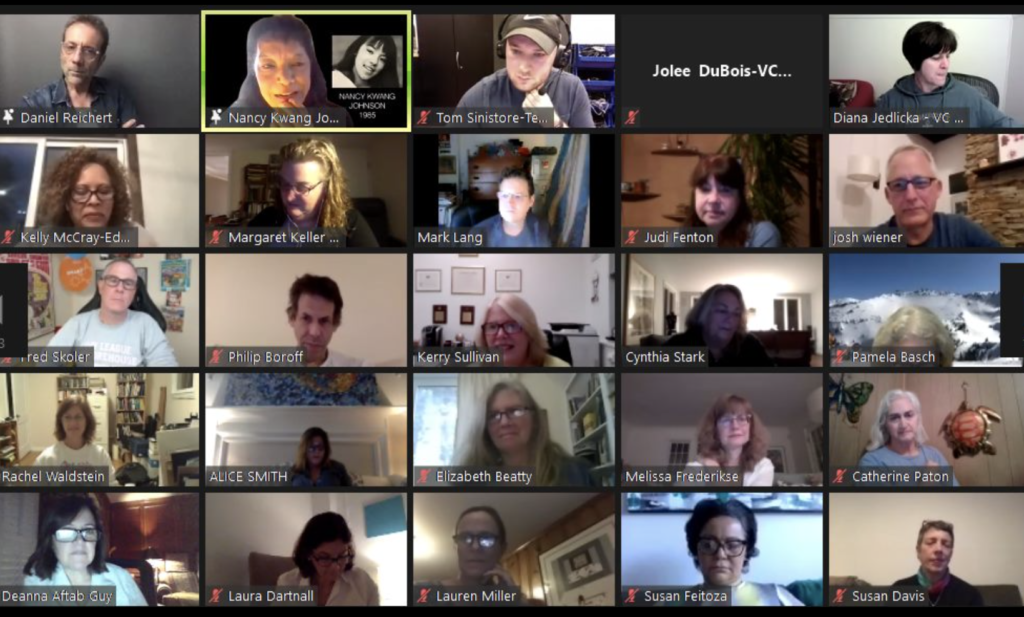Solution to “Public Gathering” in the Time of COVID-19
by Alice Smith
Originally published January 17, 2021

During a time of COVID-19 crisis, local governments took the first steps to utilize a digital tool, Zoom, to maintain mandated public gatherings. Without it, the business of the people could not have gotten done and going forward, this tool is likely to stay and continue to bring people together.
COVID-19
The CDC confirmed the first case of COVID-19 in the United States on January 21, 2020, but it was not declared a pandemic until March 11, 2020. The timeline of events reveals facts around the virus. Whether people believed it was real or not—there were many groups who engaged in spreading controversy around the idea that the COVID-19 /Coronavirus was a hoax —the world-at-large shut down in early 2020 in the hopes to temper the spread of this deadly virus. As the first pandemic in over 100 years, it wreaked utter havoc in every area of our lives. It stopped travel, manifested devastating job loss, shut down restaurants, kept children from going to school, filled hospital beds and brought illness and death among so many other things that are still not accounted for.
Once there was a universal agreement that we had to quarantine, there were efforts to revisit how we get together again.
The decision was made to let technology be our guide. People everywhere scrambled to find the right tool that allowed gatherings to happen on a tech platform that kept them well and informed us in a safe, socially-distanced way. Zoom was the tool of choice.
Evolution of Social Distancing
Social distancing became the solution to minimize the spread of COVID-19. There were general questions : should people quarantine? Should they wear masks? If we do get together, how many people can be in a room and how many feet should we distance from each other? Are doorknobs and common surfaces places that breed the virus?

While individuals and companies followed some of the CDC guidelines to stay put and close their doors to the public, the local state governments had to make swift decisions about how to control behaviors. The federal government–the White House–turned a blind eye to taking the lead and responsibility, leaving it to governors, mayors, selectmen, local agencies to establish rules of their own. Governors started to issue executive orders. The State of Connecticut, under the direction of Governor Ned Lamont, issued the state’s first one on March 12, 2020 which limited public gatherings to 250 people, waived the 180-day school year, restricted nursing home visits and a few other actions.
Connecticut soon started to introduce more aggressive restrictions. But by May 1, 2020, with increasing pressure from municipalities, towns and cities all over the state, Governor Lamont issued Executive Order 7HH, that allowed the use of technologies ……”[to] conduct any meeting, election, or vote by telephonic, video, or other conferencing process, or by ballot without a meeting.”
Of the 89 executive orders issued to date, this order was not restrictive but freeing!
Zoom to the Rescue
The major tool that most businesses, schools, government agencies started to use was called Zoom. Business Insider defined Zoom as “a cloud-based video communications app that allows you to set up virtual video and audio conferencing, webinars, live chats, screen-sharing and other collaborative capabilities.” The original users of Zoom tended to be companies whose clients and employees needed to meet face to face but either did not have the time or were too distant to travel to meet in person. Zoom allowed for more than one person to collaborate on one screen in real time. It also allowed users to engage for free for up to 40 minutes, which got people hooked. Zoom’s subscription service then allowed additional bells and whistles that government meetings require: unlimited time length, script saving, a chat room for public engagement, file sharing, recording of the meeting. It is a source of “fact storage”: proof that the meeting happened and is assumed unmanipulable.
In CT, the public meeting always requires widespread invitation to the public, where they have opportunity to participate and comment, providing full transparency. The act called “Freedom of Information”, created in 1975, allowes individuals to request any and all data discussed and distributed surrounding that meeting. Content encompassed minutes and other documents pertaining to the events at the meeting.
Legally, without a public meeting, the business of government can’t get done. That means employees, commissions and boards cannot do or pursue the “business of government”; they cannot spend the people’s money without their knowledge and permission. They can’t collect taxes, notarize documents, issue permits, record property transactions, inspect buildings, test well water, fix and plow roads, collect garbage and even pay public employees like teachers. But government could continue if the public was invited to participate and order 7HH enabled this. In fact, video gatherings allowed for more people to participate from the comfort of their homes and resulted in more interaction and transparency. Zoom was a huge success.
Crisis of “Zoombombing” and Privacy Issues
Zoom had some real issues at the start of the pandemic, as it was being used by just about every organization to reach their audiences, becoming critical infrastructure . Meetings and education had to continue so as not to lose business or momentum in learning. “Zoombombing” became a real problem where “internet trolls” would hijack video conferences and generally disrupt and in many cases, insert all kinds of lewd, racist and obscene content in the meeting. The response of these attacks would result in widespread shutdown of videoconferences hosted by schools, businesses and social groups until the privacy issues were addressed by the organizations themselves and then by the CEO of Zoom. Zoom apologized and then published a guide to help users avoid these incidents.
Exemplary Public Engagement
In an interview with the Executive Assistant to the First Selectman of Ridgefield, she emphasized how at first, they had trouble with the Zoom format. The pauses, glitches, screen-freezes, and constant muting while speaking were detriments. Eventually they got used to the technology and the most notable and positive thing surprised them: the public showed up tenfold. Where there used to be a handful of audience members, Zoom could easily host 100 to 200 people in an average meeting. And they were all engaged.
I asked when COVID is over, should people return to the “old” way? She asked me “Why? What used to be one meeting a day, that took a half day in travel time to get to, with Zoom one can now accomplish five meetings before noon.”
This “crisis” effect inadvertently revealed local governments becoming more nimble, innovative and open to new technologies and new ideas. We saw this in the response to the wide-spread adoption of ballots via mail so individuals wouldn’t have to be in contact with other people in a voting space. Contrast this innovation with the past unwillingness of governments to incorporate use of personal cell phone and email communication with citizens against the traditional delivery systems: snail mail or in- person. Going forward, post-pandemic, this Zoom success should encourage government to be more innovative and experimental.

It appears that most groups of people seem to be engaging with Zoom. Most schools use the platform, though with some challenges. Families host dinner nights together. Friends host cocktail and dance parties. Musicians perform for their fans and even charge admission. Artists do poetry readings or teach students to paint or craft. Theatre groups engage other actors to develop their craft. Doctors see patients. Churches deliver eulogies. Yoga and fitness instructors get their students to move. The local Mark Twain Library in Redding, CT regularly hosts their programs on Zoom. They even hosted their swankiest event this year, one that is usually is set under the stars, in a magnificent setting. A virtual “table of tickets” sold for as much as $10,000 to witness the “The Pudd’nhead Prize” on Zoom for just an hour of repartee between Laura Linney and Michael Ian Black. Zoom is now used for all forms of public gatherings.
In fact, Zoom is now a verb. You often hear the phrase, “let’s Zoom”.
Zoom brought us together when no other options existed. Clearly Zoom is another tool in the Strategic Communications & Public Relations toolbox that we will have to master.
• • •
Alice Smith is currently enrolled in Sacred Heart University’s Strategic Communications and Public Relations Graduate Program @sacredheart.edu. She works at the Town of Redding, CT as the Executive Assistant to the First Selectman, www.townofreddingct.org. She is also a collage artist and engages in public art projects when time allows, www.alicesmithart.com, @alice.smith.art.
